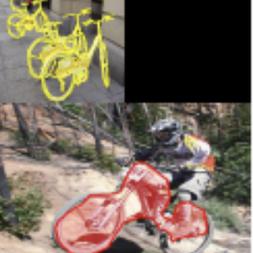Semantic Segmentation
5276 papers with code • 126 benchmarks • 313 datasets
Semantic Segmentation is a computer vision task in which the goal is to categorize each pixel in an image into a class or object. The goal is to produce a dense pixel-wise segmentation map of an image, where each pixel is assigned to a specific class or object. Some example benchmarks for this task are Cityscapes, PASCAL VOC and ADE20K. Models are usually evaluated with the Mean Intersection-Over-Union (Mean IoU) and Pixel Accuracy metrics.
( Image credit: CSAILVision )
Libraries
Use these libraries to find Semantic Segmentation models and implementationsSubtasks
-
 Tumor Segmentation
Tumor Segmentation
-
 Panoptic Segmentation
Panoptic Segmentation
-
 3D Semantic Segmentation
3D Semantic Segmentation
-
 Weakly-Supervised Semantic Segmentation
Weakly-Supervised Semantic Segmentation
-
 Weakly-Supervised Semantic Segmentation
Weakly-Supervised Semantic Segmentation
-
 Scene Segmentation
Scene Segmentation
-
 Semi-Supervised Semantic Segmentation
Semi-Supervised Semantic Segmentation
-
 Real-Time Semantic Segmentation
Real-Time Semantic Segmentation
-
 3D Part Segmentation
3D Part Segmentation
-
 Unsupervised Semantic Segmentation
Unsupervised Semantic Segmentation
-
 Road Segmentation
Road Segmentation
-
 One-Shot Segmentation
One-Shot Segmentation
-
 Bird's-Eye View Semantic Segmentation
Bird's-Eye View Semantic Segmentation
-
 Crack Segmentation
Crack Segmentation
-
 UNET Segmentation
UNET Segmentation
-
 Universal Segmentation
Universal Segmentation
-
 Class-Incremental Semantic Segmentation
Class-Incremental Semantic Segmentation
-
 Polyp Segmentation
Polyp Segmentation
-
 Vision-Language Segmentation
Vision-Language Segmentation
-
 4D Spatio Temporal Semantic Segmentation
4D Spatio Temporal Semantic Segmentation
-
 Histopathological Segmentation
Histopathological Segmentation
-
 Attentive segmentation networks
Attentive segmentation networks
-
 Text-Line Extraction
Text-Line Extraction
-
 Aerial Video Semantic Segmentation
Aerial Video Semantic Segmentation
-
 Amodal Panoptic Segmentation
Amodal Panoptic Segmentation
-
 Robust BEV Map Segmentation
Robust BEV Map Segmentation
Latest papers with no code
Leveraging Fixed and Dynamic Pseudo-labels for Semi-supervised Medical Image Segmentation
To this end, we propose a novel approach where multiple pseudo-labels for the same unannotated image are used to learn from the unlabeled data: the conventional fixed pseudo-label and the newly introduced dynamic pseudo-label.
Building a Strong Pre-Training Baseline for Universal 3D Large-Scale Perception
Such inconsiderate consistency greatly hampers the promising path of reaching an universal pre-training framework: (1) The cross-scene semantic self-conflict, i. e., the intense collision between primitive segments of the same semantics from different scenes; (2) Lacking a globally unified bond that pushes the cross-scene semantic consistency into 3D representation learning.
In The Wild Ellipse Parameter Estimation for Circular Dining Plates and Bowls
Ellipse estimation is an important topic in food image processing because it can be leveraged to parameterize plates and bowls, which in turn can be used to estimate camera view angles and food portion sizes.
Global Motion Understanding in Large-Scale Video Object Segmentation
Namely, we focus on integrating scene global motion knowledge to improve large-scale semi-supervised Video Object Segmentation.
ADLDA: A Method to Reduce the Harm of Data Distribution Shift in Data Augmentation
This study introduces a novel data augmentation technique, ADLDA, aimed at mitigating the negative impact of data distribution shifts caused by the data augmentation process in computer vision task.
DeVOS: Flow-Guided Deformable Transformer for Video Object Segmentation
For short-term local propagation, we propose a novel attention mechanism ADVA (Adaptive Deformable Video Attention), allowing the adaption of similarity search region to query-specific semantic features, which ensures robust tracking of complex shape and scale changes.
Multi-level Personalized Federated Learning on Heterogeneous and Long-Tailed Data
Federated learning (FL) offers a privacy-centric distributed learning framework, enabling model training on individual clients and central aggregation without necessitating data exchange.
VLSM-Adapter: Finetuning Vision-Language Segmentation Efficiently with Lightweight Blocks
Foundation Vision-Language Models (VLMs) trained using large-scale open-domain images and text pairs have recently been adapted to develop Vision-Language Segmentation Models (VLSMs) that allow providing text prompts during inference to guide image segmentation.
Enhancing Weakly Supervised Semantic Segmentation with Multi-modal Foundation Models: An End-to-End Approach
Weakly-Supervised Semantic Segmentation (WSSS) offers a cost-efficient workaround to extensive labeling in comparison to fully-supervised methods by using partial or incomplete labels.
Zero-shot Degree of Ill-posedness Estimation for Active Small Object Change Detection
To regularize this problem, we apply the conceptof self-supervised learning to achieve efficient DoI estimationscheme and investigate its generalization to diverse datasets. Specifically, we tackle the challenging issue of obtaining self-supervision cues for semantically non-distinctive unseen smallobjects and show that novel "oversegmentation cues" from openvocabulary semantic segmentation can be effectively exploited. When applied to diverse real datasets, the proposed DoI modelcan boost state-of-the-art change detection models, and it showsstable and consistent improvements when evaluated on real-world datasets.































































































































 MS COCO
MS COCO
 Cityscapes
Cityscapes
 KITTI
KITTI
 ShapeNet
ShapeNet
 ScanNet
ScanNet
 ADE20K
ADE20K
 NYUv2
NYUv2
 DAVIS
DAVIS
 SYNTHIA
SYNTHIA
 EuroSAT
EuroSAT